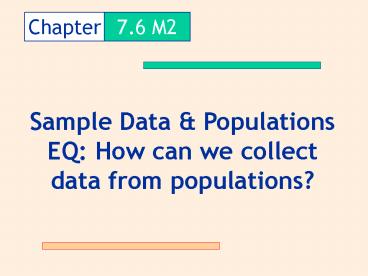7.6 M2 - PowerPoint PPT Presentation
1 / 13
Title:
7.6 M2
Description:
Title: PowerPoint Presentation Author: Heather Last modified by: e199500839 Created Date: 9/4/2002 12:54:49 AM Document presentation format: On-screen Show – PowerPoint PPT presentation
Number of Views:6
Avg rating:3.0/5.0
Title: 7.6 M2
1
Chapter
7.6 M2
Sample Data Populations EQ How can we collect
data from populations?
2
The Sample Plan is the process followed to select
units from the population to be used in the sample
3
Basic Concepts in Samples and Sampling
- Population the entire group under study as
defined by research objectives. Sometimes called
the universe. - Researchers define populations in specific terms
such as heads of households, individual person
types, families, types of retail outlets, etc.
Population geographic location and time of study
are also considered.
4
5
Basic Concepts in Samples and Samplingcont.
- Statistic a numerical description of a sample
characteristic - parameter a numerical description of a
population characteristic. The mean of a
population is an example of a population
parameter. - Population mean The true mean of the entire
population
6
Reasons for Taking a Sample
- Practical considerations such as cost and
population size - Inability of researcher to analyze large
quantities of data potentially generated by a
census - Samples can produce sound results if proper rules
are followed for the draw
7
Probability Sampling Methods Simple Random
Sampling
- Simple random sampling the probability of being
selected is known and equal for all members of
the population - Blind Draw Method (e.g. names placed in a hat
and then drawn randomly) - Random Numbers Method (all items in the sampling
frame given numbers, numbers then drawn using
table or computer program) - Advantages
- Known and equal chance of selection
- Easy method when there is an electronic database
8
(No Transcript)
9
Ex 1 Collect data by random sampling
- A country club has 345 social members and 876
golf members. The president of the country club
wants to form a random sample of 20 social
members and a separate random sample of 50 golf
members to answer some survey questions. Each
social member has a membership number from 1-345
and each golf member has a membership number from
1001 to 1876. Use a graphing calculator to select
the members who will participate in each random
sample.
10
The Solution Keystrokes math, prb, 5(randInt)
- Use the random integer feature of a graphing
calculator to generate 20 random integers between
1 and 345. - Use the arrows to scroll over and see the rest of
the random values. - Document the values this list makes up your
random sample of social members. - Now use the random integer feature to generate 50
random integers between 1001 and 1876. - Use the arrows to scroll over and see the rest of
the random values. - Document the values this list makes up your
random sample of golf members.
11
Ex2 Compare statistics and parameters
- A schools math club wants to know how many hours
students spend on math homework each week.
Savannah and Miguel, two students in the math
club, collect separate random samples. Their
results are displayed on page 274 of the M2
textbook. - The population mean is 11.9 and the population
standard deviation is about 6.7. Compare the
means and the standard deviations of the random
samples to the population parameters.
12
Lets compare results
- Savannah
- X-bar 9.8
- Std. deviation 3.6
- Miquel
- X-bar 12.7
- Std. deviation about 4.2
- The mean of Savannahs sample is less than the
population mean. - The mean of Miguels sample is greater than the
population mean. - The standard deviations of both samples are less
than the population standard deviation. - This indicates that the samples are less varied
than the entire population.
13
Homework
page 276 1-7 all, 9































